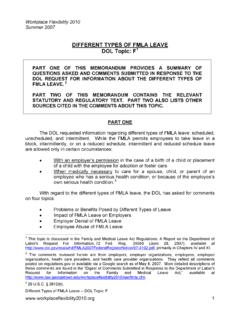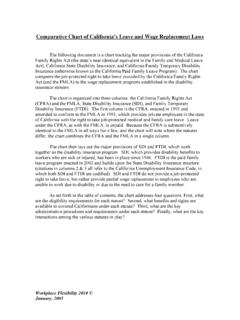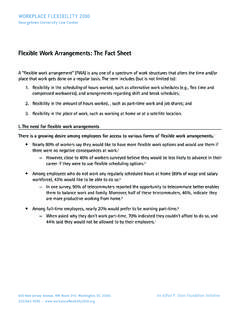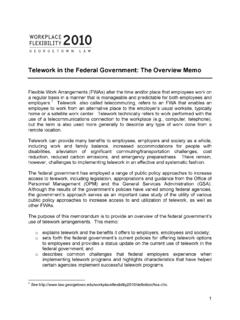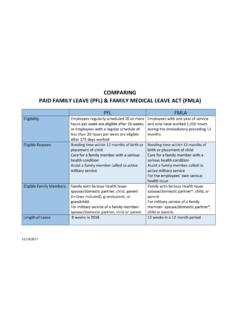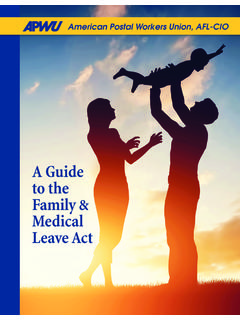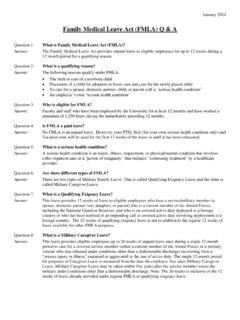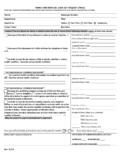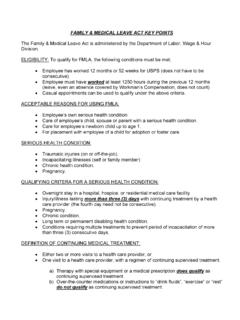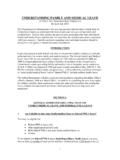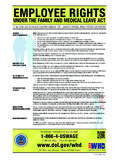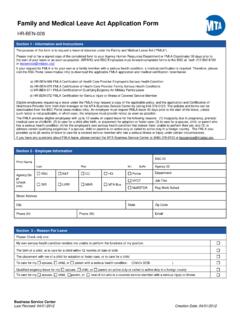Transcription of INTERMITTENT LEAVE UNDER THE FAMILY AND …
1 INTERMITTENT LEAVE AND REDUCED SCHEDULE LEAVE UNDER THE FAMILY AND medical LEAVE ACT The FAMILY and medical LEAVE Act of 1993 ( fmla ) permits workers who meet certain conditions to take up to 12 weeks per year of unpaid LEAVE for medical or FAMILY care This memorandum discusses the statutes, legislative history and regulations pertinent to INTERMITTENT and reduced schedule LEAVE , as well as select case law. To give workers not just the time but also the flexibility to balance the demands of work and FAMILY , the fmla allows workers to take LEAVE on an INTERMITTENT basis ( , a few hours per week to attend a standing medical appointment) or on a reduced work schedule ( , working a three-day week while recovering from cancer). Generally, INTERMITTENT LEAVE or reduced schedule LEAVE is provided when medically necessary for an employee s own serious health condition or for caretaking of certain FAMILY members with serious health In such circumstances, an employee need not obtain the prior approval of his or her employer to take such LEAVE .
2 By contrast, INTERMITTENT LEAVE or a reduced schedule LEAVE may be used for care related to the birth/adoption/foster care of a child only if the employer gives prior approval for such arrangements. The fmla statute authorizes INTERMITTENT and reduced schedule LEAVE (though it defines only the latter), provides that employees taking such LEAVE may be charged only for the actual amount of LEAVE they take, requires notice and certification of LEAVE , requires employees to schedule planned treatments in a manner that does not unduly disrupt the employer s operations (subject to health care provider approval), and permits employers to transfer employees needing such LEAVE to alternative positions that better accommodate INTERMITTENT LEAVE or a reduced schedule. The fmla regulations reiterate the statutory requirements and add additional rules on implementation of INTERMITTENT and reduced schedule LEAVE , including defining INTERMITTENT LEAVE , explaining how to demonstrate that LEAVE is medically necessary, tracking LEAVE in increments of one hour or less, requiring notice of LEAVE only once in most circumstances, and allowing employers to dock pay for fmla LEAVE without having the employee lose exempt status UNDER the Fair Labor Standards Act (FLSA) (which, among other things, requires overtime pay for employees who are considered non-exempt).
3 1 29 2601 et seq.; 29 et seq. Title II of the fmla , governing most federal employees, is not discussed here, nor are any special provisions governing employees of local education agencies. 2 A serious health condition refers to an illness that requires either inpatient care or continuing treatment. For a full discussion of serious health conditions see Workplace Flexibility 2010, Eligibility for medical LEAVE UNDER the fmla (2004). Workplace Flexibility 2010 January 2005 1 The Statute The fmla permits employees to take LEAVE intermittently or on a reduced schedule basis when medically necessary for their own serious health conditions or to care for certain FAMILY members with serious health Employers must approve INTERMITTENT or reduced schedule LEAVE for reasons related to birth/adoption/foster care of a The statute does not define INTERMITTENT LEAVE .
4 It defines reduced LEAVE schedule as a LEAVE schedule that reduces the usual number of hours per workweek, or hours per workday, of an employee. 5 Employees may not be charged against their fmla entitlement for INTERMITTENT or reduced schedule LEAVE beyond the amount of LEAVE they actually When an employee requests INTERMITTENT LEAVE , or reduced schedule LEAVE , for planned medical treatment, the employer may temporarily transfer the employee to an available alternative position that better accommodates recurring absences or part-time The employee must receive the same pay and benefits in the alternative position that the employee received in the prior The employee is required to give the employer notice of his or her need for foreseeable INTERMITTENT LEAVE , or foreseeable reduced schedule LEAVE , at least 30 days before the LEAVE is to If treatment requires the LEAVE to begin earlier, the employee must give the notice as practicable.
5 10 The burden is on the employee to make a reasonable effort to schedule foreseeable medical treatments (for himself or herself, or for a FAMILY member) in a manner that does not unduly disrupt the employer s This scheduling is subject to the approval of the employee s health care provider or the FAMILY member s health care Upon receiving a request for medical LEAVE (continuous, INTERMITTENT , or reduced schedule), the employer may require a certification from the employee s health care provider or the health care provider of the employee s FAMILY member for whom caregiving is sought. (See Workplace Flexibility 2010, Eligibility for medical LEAVE 3 29 2612(b)(1). Immediate FAMILY member includes a spouse, child or parent, but not, for example, a parent-in-law or domestic partner. See 29 2612(a)(1), 2611(7),(12) 29 4 29 2612(b)(1).)
6 5 29 2611(9). 6 29 2612(b)(1). 7 29 2612(b)(2). 8 Id. 9 29 2612(e)(2)(B). 10 Id. 11 29 2612(e)(2)(A). 12 Id. Workplace Flexibility 2010 January 2005 2 UNDER the fmla (2004) for a general description of medical certifications and their required content.) When the employee has requested reduced schedule LEAVE , or INTERMITTENT LEAVE , because the employee has planned medical treatments for his or her own health condition, and the employer has in turn required a certification from the employee, the certification must include the dates on which such treatment is expected and the duration of the When the employee has requested a reduced schedule, or INTERMITTENT LEAVE , for his or her own health condition (but not for scheduled medical treatments), the certification must state that there is a medical necessity for such LEAVE and must include a statement of the expected duration of the INTERMITTENT /reduced schedule There is no requirement that the certification set forth the expected schedule for such INTERMITTENT LEAVE presumably because there will be no set schedule for such LEAVE .
7 (For example, if the INTERMITTENT LEAVE is required for flare-ups of chronic conditions.) When the employee has requested a reduced schedule LEAVE , or INTERMITTENT LEAVE , in order to care for a FAMILY member with a serious health condition, the FAMILY member s health care provider must state that the employee s INTERMITTENT /reduced schedule LEAVE is necessary for the care of the FAMILY In addition, the certification must include a statement of the expected duration and schedule of the INTERMITTENT /reduced schedule The Legislative History Given the amount of practical energy expended on INTERMITTENT LEAVE and reduced schedule leaves by human resource professionals since the fmla s passage, Members of Congress gave the issue relatively little attention. Committee reports accompanying the final fmla bill enacted by the 103rd Congress contain only five paragraphs on general INTERMITTENT and reduced schedule LEAVE requirements, one paragraph regarding INTERMITTENT or reduced schedule LEAVE for planned medical treatment and one paragraph regarding medical certifications for INTERMITTENT or reduced schedule These reports indicated that the committees focused primarily on two possible uses of INTERMITTENT LEAVE when an employee needs a few hours off per week to receive a medical treatment ( , chemotherapy or physical therapy), or when an employee suffers from a type of condition that requires a reduced hours (part-time) schedule for some period of time ( , while recovering from major surgery).
8 13 29 2613(b)(5). 14 29 2613(b)(6). 15 29 2613(b)(7). 16 Id. 17 See 103-8(I)(1993), at 39, 41; S. Rep. 103-3(1993), at 23, 26. Two House committee reports accompanied the fmla one by the Committee on Education and Labor dealing with Title I of the Act, and the other by the Committee on Post Office and Civil Service, dealing with Title II. Because this memo focuses solely on Title I of the Act, all references to the House Committee Report refer to the report by the Committee on Education and Labor, unless otherwise noted. Workplace Flexibility 2010 January 2005 3 Based on these intended uses, the reports emphasize two principles: ! Employees should be charged LEAVE only for the time actually taken. The committee reports state ..an employee who takes four hours of LEAVE for a medical treatment has utilized only 4 hours of the 12 weeks of LEAVE to which the employee is entitled.
9 18 Similarly, in discussing continuing treatment or supervision of a serious health condition, the reports specifically note that [o]nly the time actually taken is charged against the employee s entitlement. 19 ! Employers should have flexibility to temporarily transfer employees needing INTERMITTENT LEAVE , or a reduced schedule LEAVE , to positions better suited for such recurring LEAVE or part-time work (and employees should receive equivalent pay and benefits during the temporary transfer so that they are not penalized by the transfer). In addition, the reports also indicate that the committees intended that employees support their requests for INTERMITTENT or reduced schedule LEAVE in connection with planned medical treatments (like chemotherapy and physical therapy) with medical certifications covering the medical necessity, expected duration and dates of such LEAVE upon request from the The committees apparently believed that these provisions would adequately address any possible problems with INTERMITTENT or reduced schedule LEAVE , even noting that employers would prefer this structure: We anticipate that a reduced LEAVE schedule will often be perceived as desirable by employers who would prefer to retain a trained and experienced employee part-time for the weeks that the employee is on LEAVE rather than hire a full-time temporary replacement.
10 21 The minority views of the House report assailed the majority for giving employees unrestrained discretion as to when and how to take LEAVE , rendering employer workforce planning extremely difficult. 22 Opponents of the fmla also criticized the medical certification provisions based on the belief that the broad definition of the term health care provider would undermine any protection that certifications were supposed to offer employers. According to the minority, the lack of sanctions on employees who 18 103-8(I)(1993), at 37; 103-3(1993), at 27. Similarly, when discussing the need to take INTERMITTENT LEAVE for doctor s visits related to the continuing treatment of a serious health condition, the reports again note that [o]nly the time actually taken is charged against the employee s entitlement. 103-8(I)(1993), at 41; 103-3(1993), at 30. 18 103-8(I)(1993), at 37; S.

